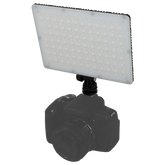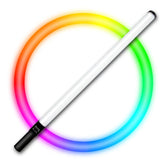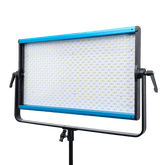Three-Point Lighting Setup Guide
Three-point lighting for professional lighting: useful information and tips
The perfect light is one of the most important means of creating images in photography and filmmaking. If you use the light correctly, you can specifically convey moods and change the atmosphere according to your ideas. You have a multitude of options for lighting design, so especially for beginners it’s not that easy, to provide optimal lighting. A good start is to deal with three-point lighting, because it forms the basis of good lighting. If you master them correctly, you only need a few light sources to achieve consistent results.
The most important things to know
- Three light sources are used in 3-point lighting: the key light as the key light, the fill light as a brightener and the back light. The three headlights are aligned so that a triangle is created.
- As the most important light source, the key light is positioned to the side of the subject and slightly higher than the camera's viewing angle.
- The fill light is intended to correct the shadow of the key light, which is why it is placed exactly opposite.
- You place the back light exactly at the opposite of the key light. It's behind the subject. In this way you ensure spatial depth, contrast and accentuation of the edges.
Three-point lighting - simply explained
The 3-point principle follows a simple background for image lighting: A natural impression of space can only be created in films or videos if the light comes from three different directions. Backlighting, light sources and shadows give an impression of spatial depth, which is particularly close to the natural visual experience that the human eye knows. Basically, regardless of where the light falls on the subject, shadows cannot be avoided. This is why a second light source is needed to lighten up these shadows, which are perceived as annoying. The third source of lighting, which is set up again at a different location, further enhances the natural impression.
3 point lighting in detail
The 3 point lighting is the elementary order in film lighting. The strongest light source is the key light, which brings the subject to be filmed into focus. It determines the direction from which the actual light comes - the so-called angle of illumination. The fill light is intended to brighten the object lighting and reduce the sharp shadows that often result from the key light. The back light behind the motif, should highlight it even more clearly from the background, which increases the spatial depth. Specifically, this means that the key and fill light are usually on the side of the camera, while the highlight is directly opposite on the other side. The following applies: No rule without exception. In special cases you can experiment and rearrange the lights. This can then be used to create very special effects.
Key light
The main light of the three-point lighting is the key light, which is why it is most important for illuminating the subject. It determines the angle of illumination - i.e. the direction from which the light comes. How you choose the lighting angle depends on the camera position. That means: First the camera is positioned and then you start with the arrangement of the light sources. The key light should be positioned next to the camera at an angle of approximately 45 degrees. Make sure to set it slightly from above so that - just like natural sunlight - it illuminates the subject from above.
Fill light
The fill light is used for brightening and is therefore an important element of the three-point lighting. It is primarily intended to reduce the shadows that inevitably emerge from the key light. This is exactly why a soft light is needed that is weaker than the key light, but still bright enough to make the dark shadows appear brighter.
Make sure that the fill light is not more dominant than the key light. The relationship between key light and fill light can be decided individually. For a classic interview, a ratio of 2: 1 to 4: 1 is used. When converting films, ratios of 8: 1 and more are also possible. For a classic interview, this means: the brightening should be no more than half as bright as the key light. A ratio of 8: 1, on the other hand, makes the contrasts appear much more pronounced, which also increases the tension in the image. So you can see that depending on the purpose, situation and location there are clear differences in relation to the ratio.
It is also important to choose the correct position for the fill light. It is best to position it on the other side of the camera - i.e. where the shadows are - at an angle of 15 to 60 degrees to the camera-subject axis. Indirect brightening is also a popular option, as it allows the shadows to be brightened naturally. The spotlight is not aimed directly at the shadow, but past the motif onto a wall or reflector. This reflects the light, which makes it less noticeable and appears softer and more uniform overall. It is ideal if the brightening is not noticeable in the finished image and is not really recognizable as a light source.
Back light
The back light represents the third element of three-point lighting. It has the task of clearly highlighting the object from its background, so that the foreground and background can be separated more easily. This makes the subject appear more three-dimensional and increases the depth of the image. If we assume an interview situation, the highlight creates a glowing ring of light. In the interviewed position, it extends from the back of the head to the shoulder. The side of the body on which the highlight is located is illuminated more intensely than the other side of the body. With the Back light, hard light is desired, which is why you should work without foil or indirect lighting. Foils are only recommended if the highlight has to be positioned too close to the person so that it is possibly brighter than the key light.
You position the back light directly behind the subject. Usually this means that it has to be opposite the key light. Ideally, it should drop in at an angle from above. An angle of 15 to 45 degrees is ideal. In this way a perfect wreath of light can be created. Also with the back light it is important to pay attention to the correct relationship to the key light, whereby different opinions and understandings exist. As a rule, professionals work with a ratio of 2: 1 to 1: 1. In some lighting situations it is also necessary that the back light is brighter than the key light. It lies behind the subject anyway, which is why it cannot replace the key light. This depends on the particular recording situation and the atmosphere and mood you want.
Which photo lamps do you need?
If you are just starting to deal with filmmaking and the requirements for 3-point lighting, you may come up with the idea of simply buying a couple of floodlights in the nearest hardware store - true to the motto: “It will be enough to try it. “We clearly advise against that. Because: The stronger the light sources, the harder the shadows that are thrown into the background by the additional film light. In addition, if a person speaks in front of the camera during an interview, small turns of the head are sufficient to create unsightly shadows on the face. The problem is also not solved by two other construction spotlights, even if you carefully position them according to the three-point lighting. Therefore, the following applies in principle: If you want to try out 3-point lighting yourself, you have to invest in professional lighting beforehand. The best thing to do is to buy a three-point lighting set. We promise: The investment is definitely worth it, because it will give you professional lighting results.
Final tips on three-point lighting
Basically, when it comes to three-point lighting, practice makes perfect! Only when you gradually gain experience you will get a knack for which relationships between the individual light sources and which positions are ideal for your shooting situations. Nevertheless, the following tips will make it easier for you to get started and help you quickly achieve great results with 3-point lighting:
- When setting up light - regardless of whether it is for photography or film and video, for testimonials or interviews - you should always first determine the camera position and the image section. Only then does it become clear which objects and room sections appear in the picture in addition to the interviewed person and must be illuminated.
- As a rule of thumb for the key light, a lighting angle of 45 degrees is recommended for three-point lighting. This value determines the position of the light source sideways to the camera. In order to recreate the impression of sunlight, to which we humans are used, the light source should also be set slightly higher. A key light positioned too high or too low often has a strange effect on the viewer. It is best to orientate yourself on the shadow cast by the nose of the person to be photographed: This shadow should fall as diagonally downwards as possible to achieve a natural picture effect.
- The interviewee's nose does not cast a shadow through the key light? Then you've either aligned it too frontally or the image lighting is too soft. This has a negative effect on the natural overall impression, because the face loses its three-dimensionality, but appears two-dimensional, mask-like and flat. The shadow shouldn't be too hard either. If you find the shadow cast by your nose too harsh, you can use foil to soften it.
- Even with the back light, it is important to ensure that it is not too strong. Otherwise, the interviewee will be given a halo. Use the back light subtly so that the person stands out from the background, the image has more depth and a realistic spatiality.
Conclusion
The three-point lighting can be implemented relatively easily if you have internalized the theoretical basics. With the right lighting equipment and a little experience, you will be able to build up tension with a few light sources, consciously influence the atmosphere and create captivating recordings. For this reason, it is worth investing in a 3-point lighting set and experimenting with it.







